Effect of Lubricating Oil and Wiper on Super-High Strength 7055 Aluminum Alloy Ingots
Abstract
1. Introduction
2. Materials and Methods
2.1. Material Preparation
2.2. Characterizations and Testing
3. Results and Discussion
3.1. The Effect of Graphite Rotor on Hydrogen Content in the Liquid Metal
3.2. Chemical Composition Analysis and Segregation of Homogenized Al7055 Ingot
3.3. The Effect of Oil-Lubrication on the Ingot Segregation Layer
3.4. The Effect of Wiper on Ingot Crack Defect
3.5. The Effect of Wiper on Microstructure of Homogenization Al7055 Ingot
4. Conclusions
- (1)
- Running three runners simultaneously during the casting process reduces the hydrogen content in the metal solution from 0.198 mL/100 g of aluminum before the degasser to 0.103 mL /100 g of aluminum after the degasser.
- (2)
- Ingots cast using the oil-lubrication hot-top casting process can improve the ingot surface. The segregation layer thickness is around 18 mm in the normal hot-top casting process. Compared to the normal hot-top casting process, the segregation thickness can be decreased to 5 mm using the oil-lubrication hot-top casting process, which greatly improves the surface quality of the ingot.
- (3)
- The wiper is very helpful for decreasing internal stress and the tendency of ingot to crack. Compared with casting without the wiper, the temperature difference between the ingot center and edge can be decreased from 320 °C to 150 °C with the wiper during the casting process, which can reduce the tendency of the ingots to crack, and this advantage can reach homogenizing effect and reduced micro-segregation during casting.
Author Contributions
Funding
Data Availability Statement
Conflicts of Interest
References
- Staley, J.T.; Lege, D.J. Advance in aluminum alloy products for structural applications in transportation. J. Phys. IV 1993, 3, 179–190. [Google Scholar]
- Wang, T.; Yin, Z.M.; Shen, K.; Li, J.; Huang, J.W. Single-aging characteristics of 7055 aluminum alloy. Trans. Nonferr. Metal. Soc. 2007, 17, 548–552. [Google Scholar] [CrossRef]
- Wang, T.; Yin, Z.M. Research Status and Development Trend of Ultra-High Strength Aluminum Alloys. Chin. J. Rare Metals 2006, 30, 197–202. [Google Scholar]
- Zhang, H.T.; Cui, J.Z.; Nagaumi, H. Study on electromagnet-air knife dc casting process of large-size AA 7055 aluminum alloys. ICAA13 Pittsburgh 2012, 77–83. [Google Scholar] [CrossRef]
- Jia, Y.W.; Wang, S.C.; Shu, D. Grain size prediction and investigation of 7055 aluminum alloy inoculated by Al-5Ti-1B master alloy. J. Alloys Compd. 2020, 821, 153504. [Google Scholar] [CrossRef]
- Cui, J.Z.; Zhang, Z.Q.; Le, Q.C. DC casting of light alloys under magnetic fields. Trans. Nonferrous Met. Soc. Chin. 2010, 20, 2046–2050. [Google Scholar] [CrossRef]
- Wang, F.Y.; Wang, X.J.; Cui, J.Z. Effect of low-frequency electromagnetic casting on micro-structure and macro-segregation of 5A90 alloy ingots. Materials 2020, 13, 2720. [Google Scholar] [CrossRef]
- Shaburova, N.; Krymsky, V.; Moghaddam, A.O. Theory and practice of using pulsed electromagnetic processing of metal melts. Materials 2022, 15, 1235. [Google Scholar] [CrossRef]
- Dong, J.; Cui, J.Z. Effects of low-frequency electromagnetic field on microstructures and macro segregation of continuous casting 7075 aluminum alloy. Mater. Lett. 2005, 59, 1502–1506. [Google Scholar] [CrossRef]
- Zuo, Y.B.; Cui, J.Z. Effect of low frequency electromagnetic field on casting crack during DC casting superhigh strength aluminum alloy ingots. Mater. Sci. Eng. A 2005, 406, 286–292. [Google Scholar]
- Dong, J.; Cui, J.Z. Effect of low-frequency electromagnetic casting on the castability, microstructure, and tensile properties of direct-chill cast Al-Zn-Mg-Cu alloy. Metall. Mater. Trans. A 2004, 35, 2487–2495. [Google Scholar] [CrossRef]
- Zhao, C.X.; Li, Y.; Xu, J.; Luo, Q.; Jiang, Y.; Xiao, Q.L.; Li, Q. Enhanced grain refinement of Al-Si alloys by novel Al-V-B refiners. J. Mater. Sci. Technol. 2021, 94, 104–112. [Google Scholar] [CrossRef]
- Fan, Z.; Wang, Y.; Zhang, Y.; Qin, T.; Zhou, X.R.; Thompson, G.E.; Pennycook, T.; Hashimoto, T. Grain refining mechanism in the Al/Al-Ti-B system. Acta Mater. 2015, 84, 292–304. [Google Scholar] [CrossRef]
- Gezer, B.T.; Toptan, F.; Daglilar, S.; Kerti, I. Production of Al-Ti-C grain refiners with the addition of elemental carbon. Mater. Des. 2010, 31, S30–S35. [Google Scholar] [CrossRef]
- Srivatsan, T.S.; Sriram, S.; Veeraraghavan, D.; Vasudevan, V.K. Microstructure tensile deformation and fracture behavior of aluminum alloy 7055. J. Mater. Sci. 1997, 32, 2883–2894. [Google Scholar] [CrossRef]
- Lukasak, D.A.; Hart, M.R. Strong aluminum alloy shaves airframe weight. Adv. Mater. Process. 1991, 10, 46–49. [Google Scholar]
- Kaibyshev, R.; Sakai, T.; Musin, F.; Nikulin, I.; Miura, H. Superplastic behavior of a 7055 aluminum alloy. Scr. Mater. 2001, 45, 1373–1380. [Google Scholar] [CrossRef]
- Dixit, M.; Mishra, R.S.; Sankaran, K.K. Structure property correations in Al 7050 and Al 7055 high-strength aluminum alloys. Mater. Sci. Eng. A 2008, 478, 163–172. [Google Scholar] [CrossRef]
- Zwiekau, E.C.; Feribebr, U.T. Possibilities for calculation heat treatment diagram of for industrial AlZnMg(Cu) alloys. Aluminium 1999, 75, 90–96. [Google Scholar]
- Poganitsch, R.; Zhang, Y.Q. Intermetallic compound in Al-Zn-Mg-Cu high strength aluminum alloy. Light Alloy. Fabr. Technol. 1984, 9, 40–44. [Google Scholar]
- You, C.P.; Thompson, A.W.; Bernstein, I.M. Ductile fracture processes in 7075 aluminum alloy. Metall. Mater. Trans. A 1995, 26, 407–415. [Google Scholar] [CrossRef]
- Li, N.K.; Cui, J.Z. Effect of Al-Zn-Mg-Cu series alloy structures on the properties. Light Alloy Fabr. Technol. 2008, 36, 5–10. [Google Scholar]
- Liu, Z.Y.; Shao, G.J.; Hu, S.C. Simulation of 7055 aluminum alloy regional water in the semi-continuous casting process. J. Hunan City Univ. 2010, 23, 5–7. [Google Scholar]
- Zhu, C.; Zhao, Z.H.; Zhu, Q.F.; Wang, G.S.; Zuo, Y.B.; Li, Q.Q.; Qin, G.W. Hot-top direct chill casting assisted by a twin-cooling field: Improving the ingot quality of a large-size 2024 al alloy. J. Mater. Sci. Technol. 2022, 112, 114–122. [Google Scholar] [CrossRef]
- Lalpoor, M.; Eskin, D.G.; Katgerman, L. Cold-cracking assessment in AA7050 billets during direct-chill casting by thermomechanical simulation of residual thermal stresses and application of fracture mechanics. Metall. Mater. Trans. A 2009, 40, 3304–3313. [Google Scholar] [CrossRef]
- Lalpoor, M.; Eskin, D.G.; Katgerman, L. Cold cracking development in AA7050 direct chill-cast billets under various casting conditions. Metall. Mater. Trans. A 2010, 41, 2425–2434. [Google Scholar] [CrossRef][Green Version]
- Elliott, H.; Simons, F.A. The Dow Chemical Co. Apparatus for Removal of Coolant from Metal Surface. U.S. Patent 3,758,913, 18 September 1973. [Google Scholar]
- Zinniger, T.C. Kaiser Aluminum & Chemical Corp. Direct Chill Casting Method with Coolant Removal. U.S. Patent 4,237,961, 9 December 1980. [Google Scholar]
- Drezet, J.M.; Pirling, T. Influence of a wiper on residual stresses in AA7050 rolling plate ingots. J. Mater. Process. Technol. 2014, 214, 1372–1378. [Google Scholar] [CrossRef][Green Version]
- Bunn, A.M.; Schumacher, P.; Kearns, M.A.; Boothroyd, C.B.; Greer, A.L. Grain refinement by Al-Ti-B alloys in aluminum melts a study of the mechanisms of poisoning by zirconium. Mater. Sci. Technol. 1999, 15, 1115–1123. [Google Scholar] [CrossRef]
- Zhu, C.; Wang, G.S.; Zhao, Z.H.; Zhu, Q.F.; Wang, S.L. Effect of 2024 al alloy insert on the grain refinement of a 2024 al alloy prepared via insert mold casting. Metals 2019, 9, 1126. [Google Scholar] [CrossRef]
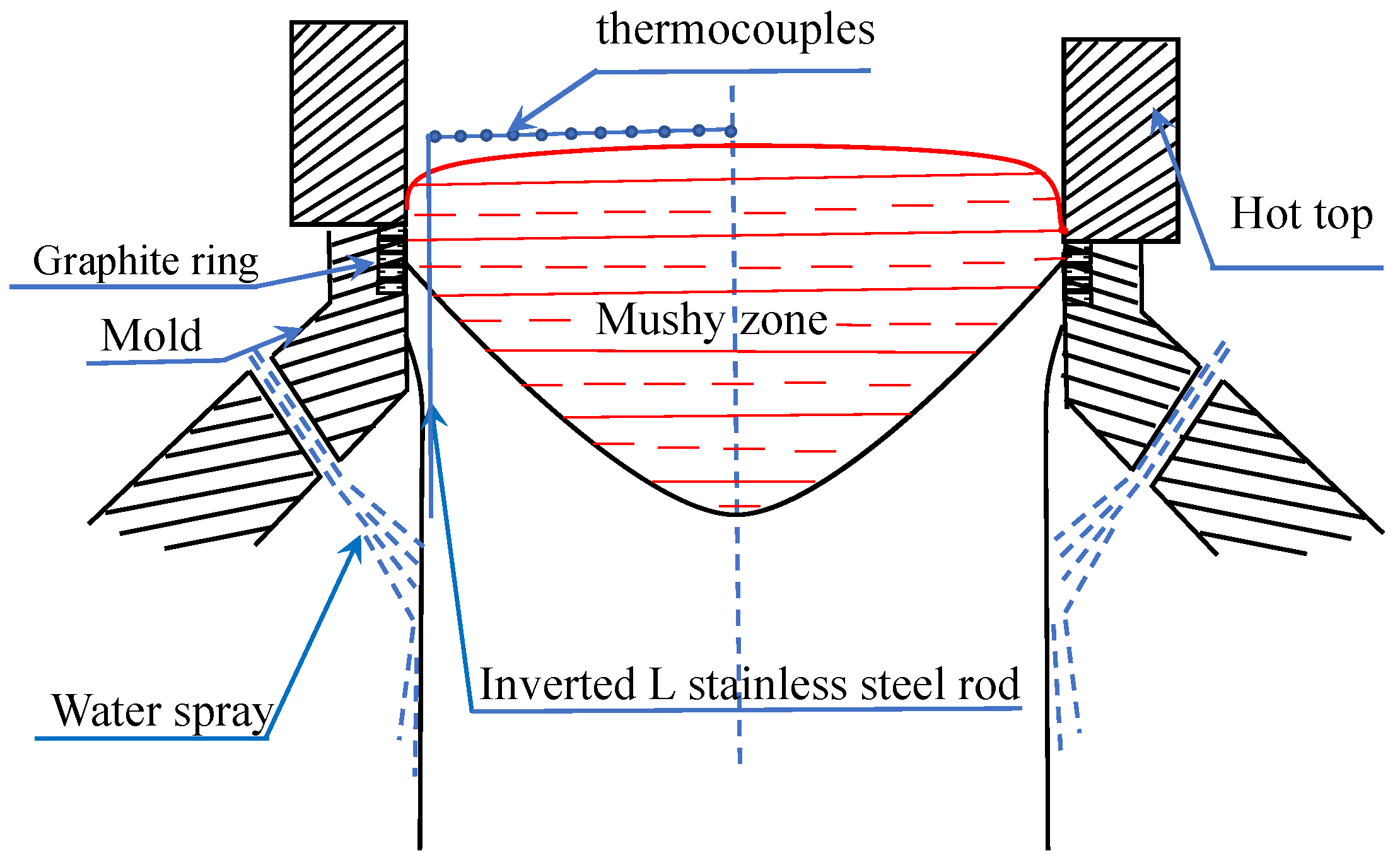
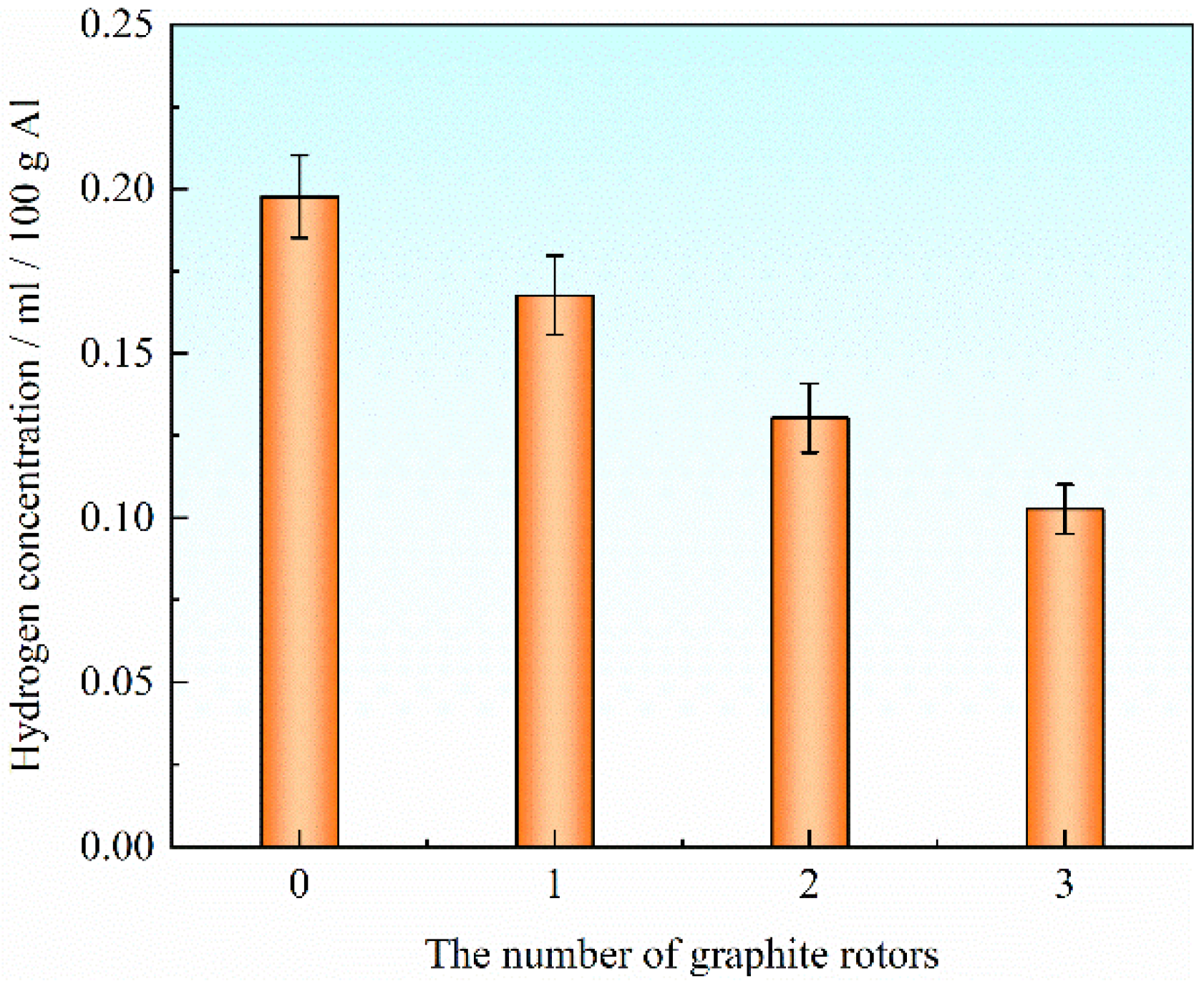

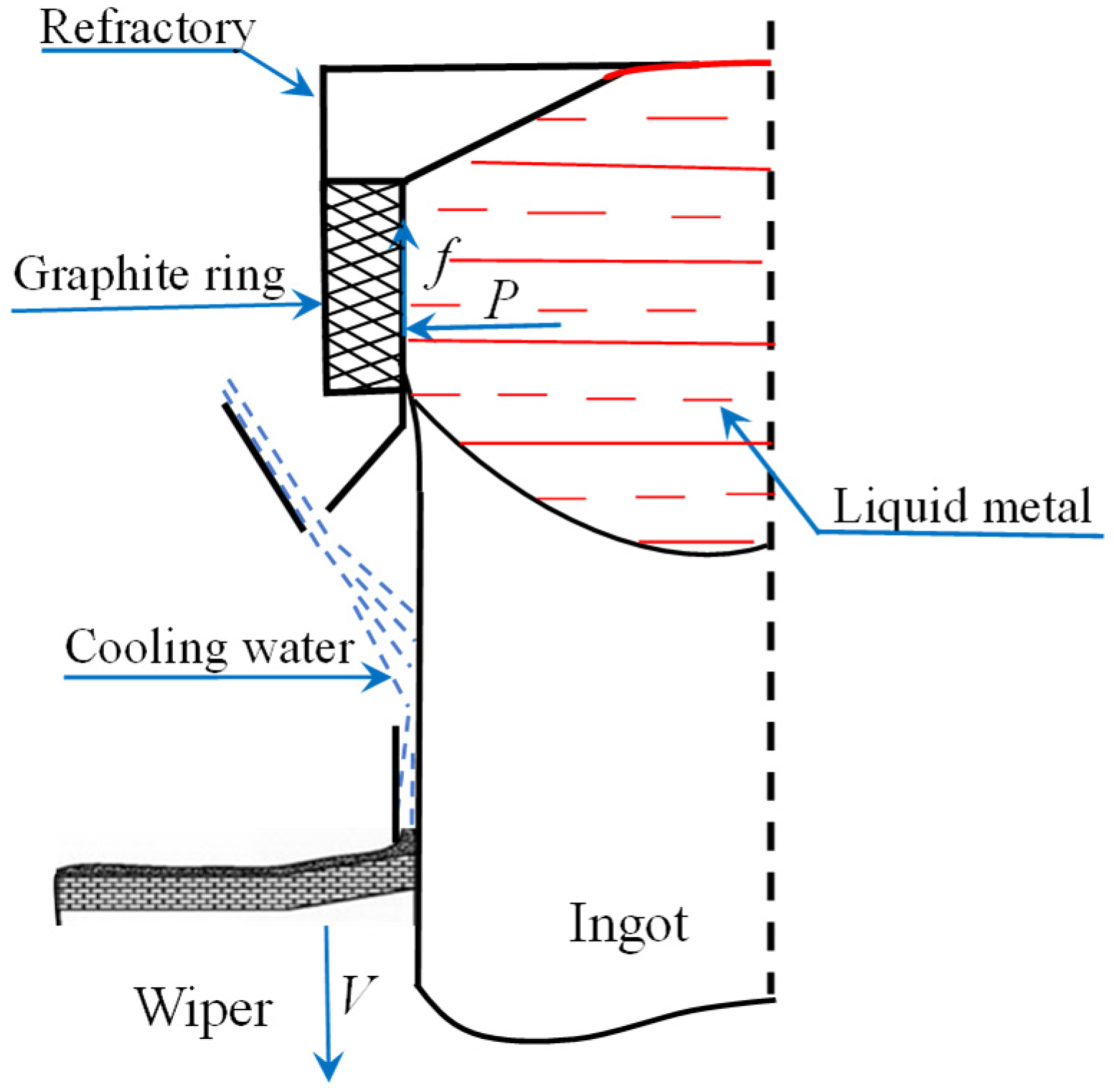
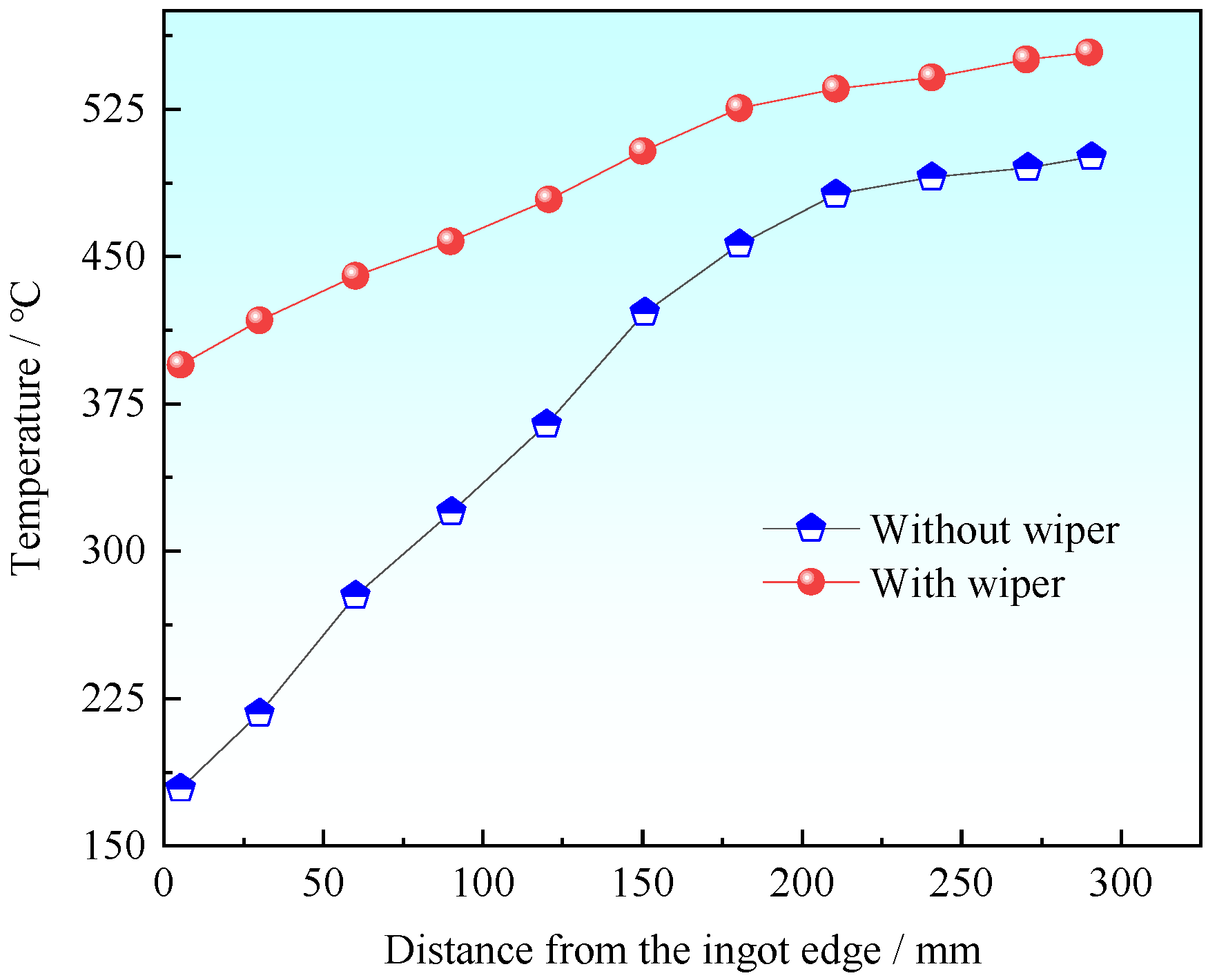
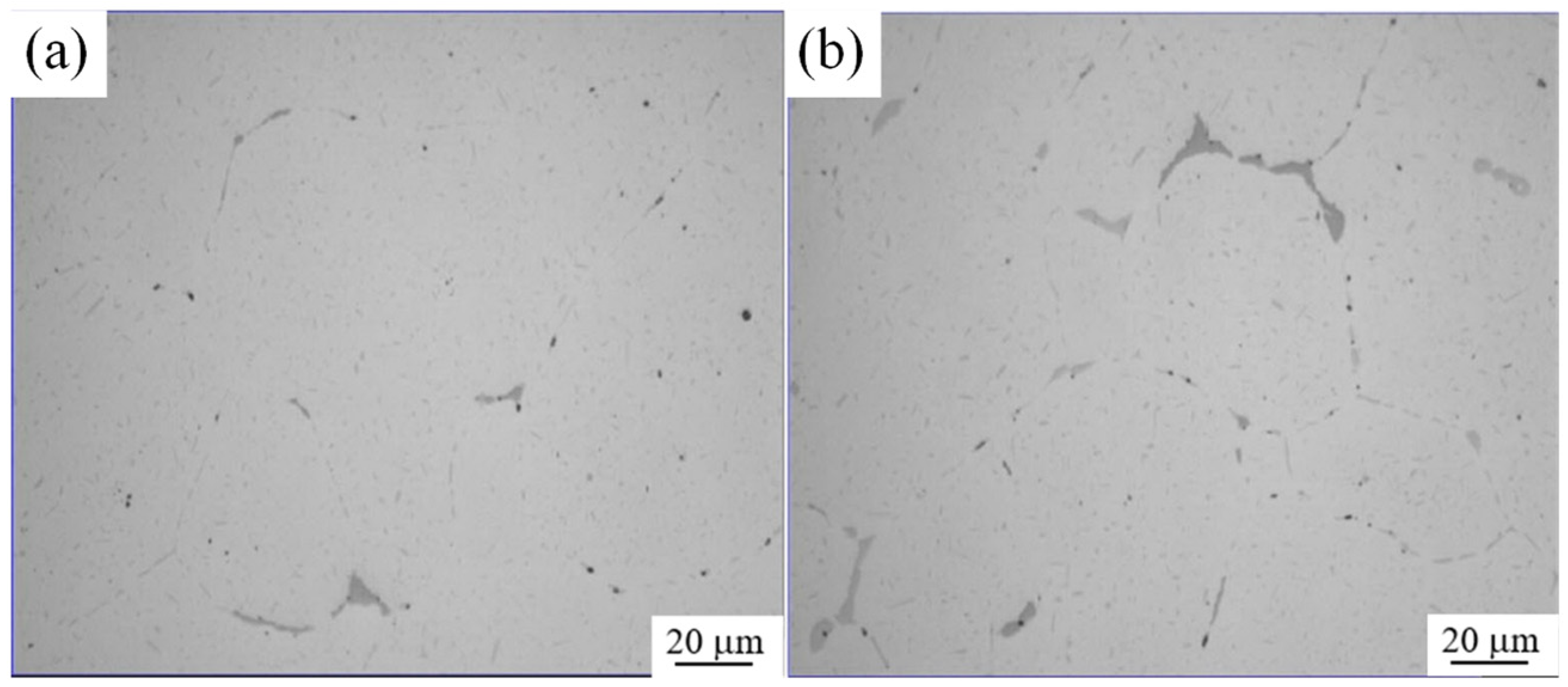
| Alloy | Si | Fe | Cu | Mn | Mg | Cr | Zn | Ti | Zr | Al |
|---|---|---|---|---|---|---|---|---|---|---|
| 7055 | 0.05 | 0.10 | 2.2 | 0.01 | 2.2 | 0.02 | 8.0 | 0.03 | 0.13 | Bal. |
| Position of the Sample | Cu | Mg | Zn | Zr |
|---|---|---|---|---|
| Edge | 2.192 | 2.182 | 8.121 | 0.132 |
| 1/2R radius | 2.101 | 2.085 | 8.027 | 0.127 |
| Center | 2.164 | 2.113 | 8.065 | 0.130 |
Disclaimer/Publisher’s Note: The statements, opinions and data contained in all publications are solely those of the individual author(s) and contributor(s) and not of MDPI and/or the editor(s). MDPI and/or the editor(s) disclaim responsibility for any injury to people or property resulting from any ideas, methods, instructions or products referred to in the content. |
© 2023 by the authors. Licensee MDPI, Basel, Switzerland. This article is an open access article distributed under the terms and conditions of the Creative Commons Attribution (CC BY) license (https://creativecommons.org/licenses/by/4.0/).
Share and Cite
Wang, X.; Xu, Y.; Yang, L.; Chen, C.; Song, Z.; Cui, J. Effect of Lubricating Oil and Wiper on Super-High Strength 7055 Aluminum Alloy Ingots. Crystals 2023, 13, 88. https://doi.org/10.3390/cryst13010088
Wang X, Xu Y, Yang L, Chen C, Song Z, Cui J. Effect of Lubricating Oil and Wiper on Super-High Strength 7055 Aluminum Alloy Ingots. Crystals. 2023; 13(1):88. https://doi.org/10.3390/cryst13010088
Chicago/Turabian StyleWang, Xiangjie, Yajun Xu, Lingfei Yang, Chengcheng Chen, Zhaoxi Song, and Jianzhong Cui. 2023. "Effect of Lubricating Oil and Wiper on Super-High Strength 7055 Aluminum Alloy Ingots" Crystals 13, no. 1: 88. https://doi.org/10.3390/cryst13010088
APA StyleWang, X., Xu, Y., Yang, L., Chen, C., Song, Z., & Cui, J. (2023). Effect of Lubricating Oil and Wiper on Super-High Strength 7055 Aluminum Alloy Ingots. Crystals, 13(1), 88. https://doi.org/10.3390/cryst13010088







